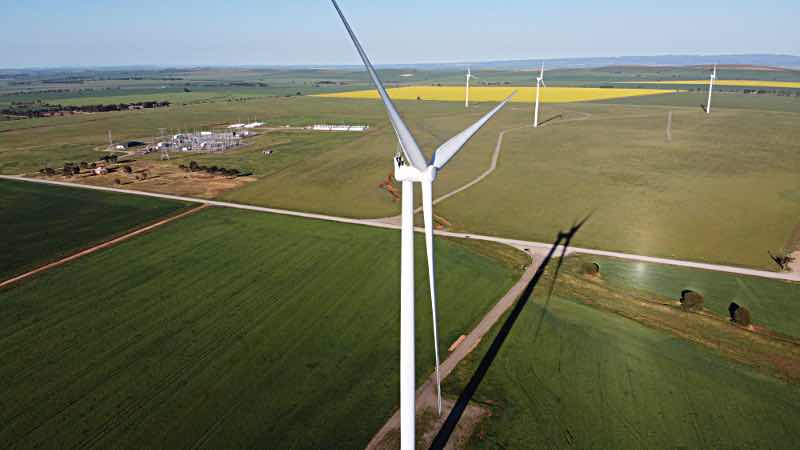| |
A part of Hornsdale Wind Farm, South Australia
|
|---|

| Mid-North SA was the leader in renewable energy development for many years
The power substation and battery can be seen on the left.
Photo taken 2021/09/23
| |
Around the end of the nineteenth century the motor car with its internal combustion engine was developed.
According to Autoblog
the engine of the Model T Ford, released in 1908, developed about 20 horsepower (~15kW).
The fuel to power the car was pumped out of the ground and refined by a fairly simple process.
Energy became more accessible and much cheaper.
Autoblog tells us that by 1955 the average car was developing around 140 horsepower (~100kW) and by 2009 it was up to 247 horsepower (~184kW).
So long as we could simply pump oil out of the ground, process it quickly and easily, and burn it for energy we had a plentiful supply that was much cheaper and more convenient than the energy of draft animals.
We became addicted to it.
A similar story could be told about the development of electric power.
The main difference with this was that it was often (especially in Australia) generated by burning another fossil fuel: coal rather than oil.
And the process fed off itself.
Cheaper energy to power drilling rigs and mining machinery meant that we could drill new oil wells and mine coal more cheaply than ever before.
In the early twenty-first century we need to kick the cheap fossil fuel energy habit because climate change is going to destroy the world as we know it, but we can't.
According to
Wikipedia
a healthy, well fed, labourer can produce about 75W of power for 8 hours.
The national minimum wage in Australia is $17.70 per hour; so $17.70 for
75 Watt-hours is a cost for human labour of (about) $0.24/Wh or $236/kWh or
$236,000/MWh.
The cost of the energy from draft animals would have been cheeper than the cost of human muscle energy, perhaps a tenth the cost, so say $20,000/MWh.
| |
Peterborough, South Australia, 4.9 MW Solar Farm
|
|---|

| |
Photo taken using my drone, 2018/05/12.
Peterborough township in the background.
The solar farm had not long been completed.
Solar farms less than 5 MW require less ancillary services to be provided by the owner than those over that capacity.
| |
According to Wikipedia in 2020 the
levelised costs of energy generation per megawatt hour were:
- Nuclear
- $170
- Thermal solar
- $140
- Coal
- $115
- Natural gas
- $60
- Wind and solar PV
- $40
On top of the generation costs are the costs of distribution and retailing. In Australia the retail price of electricity to a residential customer is typically around $0.35/kWh or $350/MWh; about 1/60th the above approximate cost of the energy of draft animals and 1/700th the cost of human energy,
Unfortunately there is a quirk of human nature that encourages us to use wastefully anything that is cheap. So as energy became cheaper and cheaper we used more and more of it, leading to more and more emissions of greenhouse gasses and health-damaging smoke and smog.

